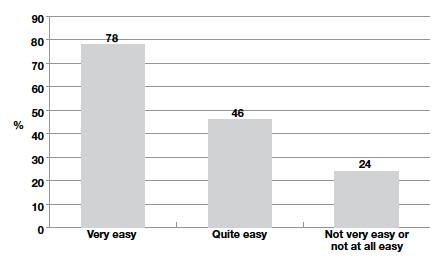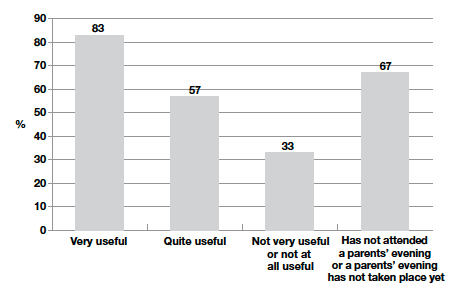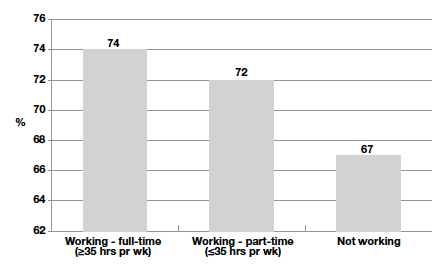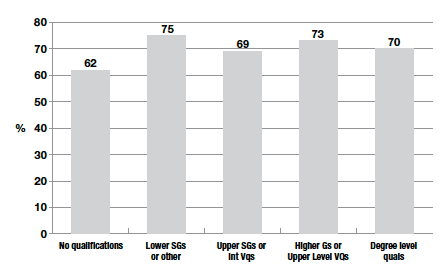Growing up in Scotland: early experiences of primary school
This research report highlights the key findings from the Growing up in Scotland early experiences study.
CHAPTER 10 SATISFACTION WITH THE CHILD'S SCHOOL
10.1 Introduction
This chapter examines reported levels of satisfaction with the child's school and variations in satisfaction levels by themes explored in earlier chapters, including school choice/allocation, information received from the school, confidence in helping the child with school work, contact with the school and level of involvement. Variations according to area and parental characteristics will also be explored. The chapter first looks at bivariate relationships between satisfaction levels and school factors and parental and area characteristics. Logistic regression analysis is then used to assess the relationship between satisfaction and various background characteristics (school-related, parental and area), while controlling for other factors. This allows us to assess which factors are independently associated with a 'very satisfied' rating.
Understanding the factors that drive parental satisfaction with schools enables causes of dissatisfaction to be addressed and/or high levels of satisfaction to be maintained. Previous research in Scotland (findings from the Scottish Household Survey 2009/2010 [Scottish Government, 2011]) indicated parents had very high levels of overall satisfaction with the education provided by their child's school - 91% of all parents with school-aged children strongly agreed/tended to agree that they were satisfied with the education provided by their child's school. This did not differ by area deprivation, and only small differences by urban/rural location were found - those in remote rural areas reported slightly lower levels of overall satisfaction (88%).
10.2 Key findings
- Overall parental satisfaction with the child's school is very high: 97% of parents responded that they were 'very' or 'fairly' satisfied with the school (71% 'very' and 26% 'fairly').
- In the bivariate analysis, school-related factors are generally associated with satisfaction in the expected way: for example greater parental involvement in school activities, receipt of information from the school about the child's learning, and approachability of teachers were all associated with higher reported satisfaction.
- In the bivariate analysis, patterns of association between parental and area characteristics and levels of satisfaction were more mixed, though some did emerge: for example, parents of 'non-white' background were less likely to say that they were very satisfied with the school compared to 'white' parents (62% and 71% respectively).
- When analysed controlling for other factors in the multivariate logistic regression, most associations of parental and area characteristics with satisfaction disappeared, though couple families had greater odds of being 'very satisfied' compared to lone parents and lower levels of socio-economic classification had a varied effect on the odds of being 'very satisfied' compared to those in managerial and professional occupations.
- The multivariate analysis showed many school-related factors were independently associated with parents' satisfaction, again mostly in the expected direction. Examples are that those not having received information from the school on how to help the child's learning had lower odds of reporting they were 'very satisfied' compared to those that had; and those who felt it was or would be less easy to approach teachers had lower odds of saying they were 'very satisfied' compared to those who thought it 'very easy'.
10.3 Exploring satisfaction by school-related factors
Parents were asked how satisfied they were with the education received by the study child at his/her current school. The majority of parents (71%) were very satisfied with the current school while 2% were fairly or very dissatisfied.
Table 10.1 Levels of satisfaction
| Satisfaction | Percentage of parents |
|---|---|
| Very satisfied | 71 |
| Fairly satisfied | 26 |
| Neither satisfied or dissatisfied | 2 |
| Fairly or very dissatisfied | 2 |
| Bases | |
| Weighted | 3623 |
| Unweighted | 3627 |
In this section we examine the bivariate relationships between the satisfaction indicator and various school-related factors. The 'neither satisfied or dissatisfied' category and the 'fairly or very dissatisfied' category are combined for this analysis due to low numbers of responses in these categories.
Table 10.2 shows that in the GUS cohort (the findings were only statistically significant at the 90% level) there were differences in satisfaction by whether a place was requested at a particular school or allocated by the local authority. A slightly higher proportion of parents who requested a place were very satisfied with the school (72% compared to 70% of parents whose children were allocated a place). Conversely, those parents whose children were allocated a place by the local authority were more likely to be in the least satisfied categories.
Table 10.2 Satisfaction by whether requested or allocated a place
| Childcare type | Percentage of parents | |
|---|---|---|
| Requested | Allocated | |
| Very satisfied | 72 | 70 |
| Fairly satisfied | 26 | 27 |
| Neither satisfied or dissatisfied, fairly dissatisfied, or very dissatisfied | 2 | 4 |
| Bases | ||
| Weighted | 1165 | 2416 |
| Unweighted | 1123 | 2454 |
Parents who were confident in helping their child in all homework subjects or tasks were more likely to be very satisfied with their child's school (73%) than those parents who were not confident, either in some or all subjects (57%).
The higher the involvement in school activities (as measured by the number of activities or events the parents were involved in) the more likely the parent was to be very satisfied with the child's school. 63% of parents who had only been involved in one activity or event at the school, or none at all, reported being very satisfied with the school, compared to 77% of parents who had been involved in six or more activities or events.
A higher proportion of parents who had contact with the school through the child's school report, receiving information on the child's progress, or receiving information about what subjects their child was learning were very satisfied with the school compared to those parents who had not had contact with the school in these ways. There was no difference in the proportion answering very satisfied between parents who had received an attendance report and those parents who had not.
Table 10.3 Satisfaction by types of contact with the school
| Information from school | Percentage answering very satisfied | |
|---|---|---|
| Not mentioned | Mentioned | |
| School report | 67.8 | 72.8 |
| Attendance report | 71.6 | 71.2 |
| Child's progress | 65.0 | 72.7 |
| Subjects learned | 60.0 | 74.1 |
| None of these | 71.8 | 61.8 |
| Bases | ||
| School report | ||
| Weighted | 702 | 1780 |
| Unweighted | 680 | 1814 |
| Attendance report | ||
| Weighted | 1370 | 1112 |
| Unweighted | 1356 | 1138 |
| Child's progress | ||
| Weighted | 424 | 2057 |
| Unweighted | 384 | 2110 |
| Subjects learned | ||
| Weighted | 475 | 2007 |
| Unweighted | 429 | 2065 |
| None of these | ||
| Weighted | 2378 | 104 |
| Unweighted | 2407 | 87 |
Similarly, more parents who had received information and advice from a teacher or the school about how to help their child with his/her learning at home (not just in relation to the homework they receive) were very satisfied with the school than those parents who had not (74% and 64% respectively, data not shown). However, those parents who had spoken to any teachers about how their child was doing at school outside of parents' evenings or similar events were less likely to be very satisfied with the school than those parents who had not (68% compared to 74%, data not shown).
There was a marked difference in the proportion of parents reporting they were very satisfied with the school by how easy they felt it was or would be to approach a teacher, and also by how useful they found parents' evenings. 78% of those parents who found it very easy to approach a teacher (or thought it would be very easy) were very satisfied with the school, compared to 46% of those who found it quite easy and 25% of those who found it not very easy or not at all easy. 83% of those parents who found parents' evenings very useful reported being very satisfied with the school, compared to 33% of parents who found parents' evenings not very useful or not at all useful.
Figure 10-A Percentage of parents reporting they were very satisfied with the school by how easy they felt it was or would be to approach a teacher

Bases: weighted: 3623; unweighted: 3627
Figure 10-B Percentage of parents reporting they were very satisfied with the school by how useful they found parents' evenings

Bases: weighted: 3623; unweighted: 3627
10.4 Exploring satisfaction by parental and area characteristics
The relationship between satisfaction with the child's school and various parental and area characteristics are explored in this section.
The number of children in the household and family type were both related to parents reporting being very satisfied with their child's school. Families with four or more children and lone parent families were both less likely to report being very satisfied with the school.
Overall satisfaction was similar for ethnicity but those of 'non-white' background were less likely to express being very satisfied with the school (see Table 10.4).
Table 10.4 Satisfaction by respondent ethnicity
| Ethnicity of respondent | Percentage of parents | |
|---|---|---|
| White | 'Non-white' | |
| Very satisfied | 71 | 62 |
| Fairly satisfied | 26 | 35 |
| Neither satisfied or dissatisfied, fairly dissatisfied, or very dissatisfied | 3 | 3 |
| Bases | ||
| Weighted | 3488 | 128 |
| Unweighted | 3523 | 98 |
There was no significant relationship between socio-economic status (quintiles of SIMD, NS- SEC groups and income quintiles) and the percentage of parents reporting being very satisfied with their child's school. However, those parents not in work were less likely than full-time or part-time working parents to report being very satisfied (see Figure 10-C). Qualification levels and tenure were also related to being very satisfied with the child's school. Parents who were in social rented accommodation were less likely than parents in owner occupied accommodation or privately rented accommodation to report being very satisfied with their child's school. The relationship with parental qualifications was not as clear-cut. The lowest percentage of parents reporting being very satisfied was amongst parents with no qualifications. However, the highest percentage was amongst parents with lower Standard Grades or other qualifications (see Figure 10-D).
Figure 10-C Percentage of parents reporting they were very satisfied with the school by employment status

Bases: weighted: 3623; unweighted: 3627
Figure 10-D Percentage of parents reporting they were very satisfied with the school by highest qualification

Bases: weighted: 3623; unweighted: 3627
Neither the respondent's age nor urban/rural location were related to reporting being very satisfied with the child's school.
10.5 Multivariate analysis
In the previous sections, relationships between various socio-demographics and satisfaction, and between various school-related factors and satisfaction were examined in isolation. In this section we extend the analysis to look at these relationships while controlling for other factors. Multivariate logistic regression allows us to assess which factors are independently associated with lower satisfaction - specifically we compare those who say they are 'very satisfied' with the other categories of satisfaction. As a rough check on whether the single satisfaction question is a reasonable measure it was compared to several factors that might also reflect satisfaction with the school. This comparison suggested that the single question is a reasonable measure: for example, higher overall satisfaction was associated with factors such as parents finding the pace of learning for the child 'about right' and agreeing with the statement that the teacher supports the child.
A summary of the factors which remained significant in the logistic regression analysis is provided in Table 10.5 20 . Confidence in helping the child with their homework, receipt of information about how to help them learn, the usefulness of parents' evenings and approachability of teachers were significant predictors of being very satisfied with the school once other variables were controlled for. In contrast, parents that had not spoken to teachers about how their child was doing at school outside of parents' evenings or similar events were more likely to be very satisfied with the school than parents who had. Socio-economic status ( NS- SEC) became a significant predictor of satisfaction once other variables were controlled for, and family type remained a significant predictor, with couple families having greater odds of being very satisfied with the school. Other factors became non-significant in the presence of these variables. The analysis suggests that, unsurprisingly but reassuringly, the actions of the school and interaction with parents are important in driving satisfaction.
Table 10.5 Factors independently associated with parents reporting they are 'very satisfied' with the child's school
| School-related factors, parental and area characteristics | Significant* | Direction of relationship** |
|---|---|---|
| Confident in helping with homework (Confident in all subjects or tasks) | ||
| Confident in some but not in others, or not confident at all | <.001 | - |
| Family type (Lone parent) | ||
| Couple family | <.05 | + |
| Socio-economic classification (Managerial and professional occupations) | ||
| Intermediate occupations | NS | |
| Small employers and own account workers | NS | |
| Lower supervisory and technical occupations | NS | |
| Semi-routine and routine occupations | <.01 | + |
| Never worked | NS | |
| Has received information from school on how to help child's learning (Yes) | ||
| No | <.001 | - |
| How easy was it or would it be to approach teacher(Very easy) | ||
| Quite easy | <.001 | - |
| Not very or not at all easy | <.001 | - |
| How useful found parents' evening (Very useful) | ||
| Quite useful | <.001 | - |
| Not very useful or not at all useful | <.001 | - |
| Has not attended a parents' evening or a parents' evening has not taken place yet | <.05 | - |
| Has spoken to any teachers about how their child is doing at school outside of parents' evenings or similar events (Yes) | ||
| No | <.001 | + |
* Statistical significance is presented either as 'Not Significant' ( NS) or at three levels of 'confidence' - 95% (< .05), 99% (< .01) or 99.9% (<.001).
** A plus sign (+) indicates the characteristic is associated with greater odds of being very satisfied with the school and a minus sign (-) indicates the characteristic is associated with lower odds of being very satisfied with the school. The reference sub-group is indicated in brackets. Where the variable is not significant, the direction of the relationship has not been included.
Contact
There is a problem
Thanks for your feedback